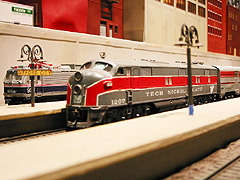Making an object for a group
The Tech Model Railroad Club of MIT
|
| |
|
The Tech Model Railroad Club is an MIT student activity over
50 years old!
TMRC caters to model railroaders, railfans, and hackers alike.
Their activities involve all aspects of model railroading,
including the application of computer technology and timetalk
passenger and card-order freight operation.
For 50 years, the club had a layout located in Building 20 on
the MIT campus. The layout modeled a portion of the Tech
Nickel Plate (TNP) railroad.
Today the club has a new room in N52-118 and is working
hard to build a new layout of the same quality as that which
used to be in Building 20. They expect to take approximately
5 years to end up with something similar to the old layout.
We were fascinated with the nature of the group itself: their concern is to reproduce objects and recreate systems to closely resemble reality. In this process, there is an interpretative synthesis of real space and a loss of functional intention.
|
Identifying an object for group / community
|
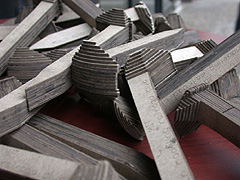
|
|
We wanted to produce an object that met
the group's desire for more student
involvement, yet wanted to fulfill our
interest in the group's unique past. The
object needed to be a significant identifier
for the context of model railroading here
at MIT. This balance of our needs versus
their needs was met through various
meetings with the club in explaining our
project and class assignment.
|
|
Making an object for a group
Railroad Spikes
|
| |
|
The initial thoughts on the design of the object were on how to best represent the community we chose to work with. Our first research was geared towards the history of the organization, their role within larger communities they might belong to (MIT, other modeling clubs), the way in which they see themselves, and the way outsiders do.
Through a series of interviews and some reading, we were able to respond to these questions, and identify the way in which the community functions.
The idea of the railroad spike sprouted out of the need for a very identifiable symbol. At the same time, a spike is just a small component of a larger network, as the club is within the realm of other clubs with similar interest and other groups at the institute. The nature of the club functions in an analogous manner: different people with different abilities and interests come together to create a world in common. A railroad spike ties the whole network together.
This idea was formed after a few proposals that
included train tracks installed from 77 Mass Ave to the
TMRC's open house in N51 to distributing model train wheels
to conjure interest in students for the club's activities.
In order to incorporate the methodology used by the community to perform their daily activities, we chose a mass production method which would not replicate, but 'model' the object. The spike, built up of several layers of chipboard, is clearly a representation of an actual object, without any pretentions of reproducing it.
The
material used for the spike was chip board after considering
wood and plastic. Chip board was used for its raw / rough
character and built from layers of laser cuts. The spike is
also a container which we used as a secret spot to put in
a flyer for the the TMRC's open house event the same day.
This space concealed within the object transforms the object into a vessel. This idea came from the agreement of the members in the club about their interest in train modeling: 'trains remind us of far away places.'
|
Mass-producing the object
The mass production of the object was done in a similar fashion to the way in which the Tech Club models their sets: this is, creating a three dimensional object from a series of cut planes. We used CAD to model the objects and a laser cutter to obtain the layers. All assembly was done by hand. There were a total of 75 objects, each one made of 28 pieces.
|
|
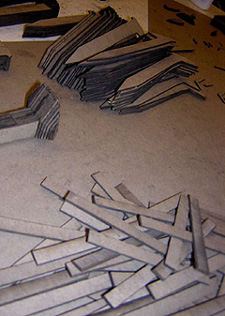
|
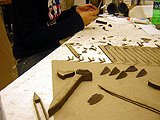
|
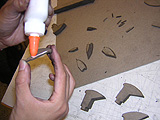
|
|
A small series of the TMRC chip board
spikes were manufactured utilizing the
laser cutter.
|

|
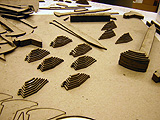
|
|
|
Making an object for a group
75 Laser Cut, Layered Chip Board Spikes
|
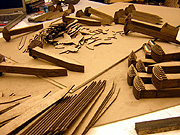
|
Distributing the object
|
| |
|
The intent of the public distribution event
was to distribute the spikes with the TMRC
information on it in a high trafficked spot
by students on the same day of the TMRC open
house, April 30. A kiosk was stationed in
front of the MIT Student Center which was
where we handed out our spikes.
|
Making an object for a group
|
Railroad Spikes
|
| |
|
The distribution point for the spikes played a key role in
meeting the club's needs for gaining additional student
interest. We wanted to be situated in a visible spot for
students passing by which would give them an opportunity
to take an object, learn more about the club, and announce
the club's open house.
Part of the project was identifying a latent need in the community we would be working with. The TMRC wanted to raise awareness of their activity on campus. At the same time, they were very reluctant to make any reference to their early affiliation to the 'hacker' culture at MIT and its beginnings. The 'hacking' aspect of the club was one of the reasons why we chose to work with this group. We wanted to incorporate it into the project in a very understated manner. We placed information inside the objects, and distributed them without informing ther recipients. The 'hack' is that they would discover the information on their own.
The objects were distributed on campus by inviting people to take an object, without revealing its significance.
|
Conclusions
Working closely with this community showed us the difficulty of translating meaning on to a single object. The first compromise was the definition of the group's identity itself, and hence, the direction in which the whole project would be directed. Once this was determined, the approval and support of the group was key in delineating not the aesthetics of the object, but of the signifier embodied in it.
The goal of bringing awareness to the greater MIT communtiy was achieved, and many of the recipients attended the TMRC's open house.
As it turns out, some recipients have discovered the hidden space in the object and have found a way to use it as a container.
|
| |


